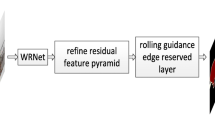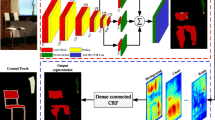Abstract
Deep convolutional neural networks (DCNNs) have shown excellent performances in the field of computer vision. In this paper, we propose a new semantic image segmentation model, and the two hallmarks of our architecture are the usage of shared decomposition convolution (SDC) operation and boundary reinforcement (BR) structure. SDC operation can extract dense features and increase correlation of features in the same group, which can relieve the grid artifact problem. BR structure combines the spatial information from different layers in DCNNs to enhance the spatial resolution and enrich target boundary position information simultaneously. The simulation results show that the proposed model can achieve 94.6% segmentation accuracy and 76.3% mIOU on PASCAL VOC 2012 database respectively, which verifies the effectiveness of the proposed model.








Similar content being viewed by others
References
Karpathy A, Li FF (2015) Deep visual-semantic alignments for generating image descriptions. IEEE Trans Pattern Anal Mach Intell 39(4):664–676
Xu K, Ba J, Kiros R, Cho K, Courville A, Salakhutdinov R, Zemel R, Bengio Y (2015) Show, attend and tell: neural image caption generation with visual attention. In: Proceedings of the advances in international conference on machine learning, pp 2048–2057
Aneja J, Deshpande A, Schwing AG (2018) Convolutional image captioning. In: Proceedings of the IEEE conference on computer vision and pattern recognition, pp 5561–5570
Papandreou G, Kokkinos I, Savalle PA (2015) Modeling local and global deformations in deep learning: epitomic convolution, multiple instance learning, and sliding window detection. In: Proceedings of the IEEE conference on computer vision and pattern recognition, pp 390–399
Dai J, Yi L, He K, Jian S (2016) R-FCN: object detection via region-based fully convolutional networks. In: Proceedings of the IEEE conference on computer vision and pattern recognition, pp 379–387
Wang C, Bai X, Wang S, Zhou J, Ren P (2019) Multiscale visual attention networks for object detection in VHR remote sensing images. IEEE Geosci Remote Sens Lett 16(2):310–314
Chen LC, Papandreou G, Kokkinos I, Murphy K, Yuille AL (2014) Semantic image segmentation with deep convolutional nets and fully connected CRFs. arXiv:1412.7062
Chen LC, Papandreou G, Kokkinos I, Murphy K, Yuille AL (2017) Deeplab: semantic image segmentation with deep convolutional nets, atrous convolution, and fully connected CRFs. IEEE Trans Pattern Anal Mach Intell 40(4):834–848
Qin AK, Clausi DA (2010) Multivariate image segmentation using semantic region growing with adaptive edge penalty. IEEE Trans Image Process 19(8):2157–2170
Jiang F, Grigorev A, Rho S, Tian Z, Fu YS, Jifara W, Adil K, Liu S (2018) Medical image semantic segmentation based on deep learning. Neural Comput Appl 29(5):1257–1265
Simonyan K, Zisserman A (2014) Very deep convolutional networks for large-scale image recognition. arXiv:1409.1556
Krizhevsky A, Sutskever I, Hinton GE (2012) ImageNet classification with deep convolutional neural networks. In: Proceedings of the advances in neural information processing systems, pp 1097–1105
Szegedy C, Liu W, Jia Y, Sermanet P, Reed S, Anguelov D, Erhan D, Vanhoucke D, Rabinovich A (2015) Going deeper with convolutions. In: Proceedings of the IEEE conference on computer vision and pattern recognition, pp 1–9
Zeiler MD, Fergus R (2014) Visualizing and understanding convolutional networks. In: Proceedings of the IEEE conference on computer vision and pattern recognition, pp 818–833
Papandreou G, Chen LC, Murphy K, Yuille AL (2015) Weakly-and semi-supervised learning of a DCNN for semantic image segmentation. arXiv:1502.02734
Lin G, Shen C, Reid I, Hengel AVD (2016) Efficient piecewise training of deep structured models for semantic segmentation. In: Proceedings of the IEEE conference on computer vision and pattern recognition, pp 3194–3203
Zheng S, Jayasumana S, Romeraparedes B, Vineet V, Su Z, Du D, Chang H, Torr PHS (2015) Conditional random fields as recurrent neural networks. In: International conference on computer vision, pp 1529–1537
Long J, Shelhamer E, Darrell T (2015) Fully convolutional networks for semantic segmentation. In: Proceedings of the IEEE conference on computer vision and pattern recognition, pp 3431–3440
Noh H, Hong S, Han B (2015) Learning deconvolution network for semantic segmentation. In: International conference on computer vision, pp 1520–1528
Fu J, Jing L, Wang Y, Lu H (2017) Stacked deconvolutional network for semantic segmentation. arXiv:1708.04943
Caponetti L, Castellano G, Basile MT, Corsini V (2014) Fuzzy mathematical morphology for biological image segmentation. Appl Intell 41(1):117–127
Chakraborty S, Thounaojam DM (2019) A novel shot boundary detection system using hybrid optimization technique. Appl Intell 49(9):3207–3220
Ahmed KT, Irtaza A, Iqbal MA (2017) Fusion of local and global features for effective image extraction. Appl Intell 47(2):526– 543
Kuang P, Ma T, Chen ZW, Li F (2019) Image super-resolution with densely connected convolutional networks. Appl Intell 49(1):125–136
Li Y, Cao G, Yu Q, Li XS (2018) Active contours driven by non-local Gaussian distribution fitting energy for image segmentation. Appl Intell 48(12):4855–4870
Deng C, Yang E, Liu T, Li J, Liu W, Tao D (2019) Unsupervised semantic-preserving adversarial hashing for image search. IEEE Trans Image Process 28(8):4032–4044
Yang E, Deng C, Li C, Liu W, Li J, Tao D (2018) Shared predictive cross-modal deep quantization. IEEE Trans Neural Netw Learn Syst 29(11):5292–5303
Deng C, Yang E, Liu T, Tao D (2019) Two-stream deep hashing with class-specific centers for supervised image search. IEEE Trans Neural Netw Learn Syst pp. 1–13. https://doi.org/10.1109/TNNLS.2019.2929068
Chen LC, Zhu Y, Papandreou G, Schroff F, Adam H (2018) Encoder-decoder with atrous separable convolution for semantic image segmentation. In: Proceedings of the advances in European conference on computer vision, pp 801–818
Liu C, Chen LC, Schroff F, Adam H, Li F (2019) Auto-deepLab: hierarchical neural architecture search for semantic image segmentation. In: Proceedings of the IEEE conference on computer vision and pattern recognition, pp 82–92
Zhou XY, Zheng JQ, Yang GZ (2019) Atrous convolutional neural network (ACNN) for semantic image segmentation with full-scale feature maps. arXiv:1901.09203
Wang P, Chen P, Ye Y, Ding L, Huang Z, Hou X, Cottrell G (2018) Understanding convolution for semantic segmentation. In: Proceedings of the advances in winter conference on applications of computer vision, pp 1451–1460
Sermanet P, Eigen D, Zhang X, Mathieu M, Lecun Y (2013) OverFeat: integrated recognition, localization and detection using convolutional networks. arXiv:1312.6229
Ren Z, Kong Q, Han J, Plumbley MD, Schuller BW (2019) Attention-based atrous convolutional neural networks: visualisation and understanding perspectives of acoustic scenes. In: Proceedings of the advances in international conference on acoustics, speech and signal processing, pp 56–60
Kalchbrenner N, Espeholt L, Simonyan K, Oord AVD, Graves A, Kavukcuoglu K (2016) Neural machine translation in linear time. arXiv:1610.10099
Chen LC, Papandreou G, Schroff F, Adam H (2017) Rethinking atrous convolution for semantic image segmentation. arXiv:1706.05587
Zhao H, Shi J, Qi X, Wang X, Jia J (2017) Pyramid scene parsing network, In: Proceedings of the IEEE conference on computer vision and pattern recognition, pp 2881–2890
Yu F, Koltun V, Funkhouser T (2017) Dilated residual networks, In: Proceedings of the IEEE conference on computer vision and pattern recognition, pp 472–480
Hamaguchi R, Fujita A, Nemoto K, Imaizumi T, Hikosaka S (2018) Effective use of dilated convolutions for segmenting small object instances in remote sensing imagery. In: Proceedings of the advances in winter conference on applications of computer vision, pp 1442–1450
Liu Z, Li X, Luo P, Loy C, Tang X (2015) Semantic image segmentation via deep parsing network. In: International conference on computer vision, pp 1377–1385
Mostajabi M, Yadollahpour P, Shakhnarovich G (2015) Feedforward semantic segmentation with zoom-out features. In: Proceedings of the IEEE conference on computer vision and pattern recognition, pp 3376–3385
Ren S, He K, Girshick R, Zhang X, Sun J (2016) Object detection networks on convolutional feature maps. IEEE Trans Pattern Anal Mach Intell 39(7):1476–1481
Zhang T, Lin G, Cai J, Shen T, Shen C, Kot AC (2019) Decoupled spatial neural attention for weakly supervised semantic segmentation. IEEE Trans Multimedia PP(99):1–11
Liu Y, Yu J, Han Y (2018) Understanding the effective receptive field in semantic image segmentation. Multimed Tools Appl 77(17):22159–22171
Vemulapalli R, Tuzel O, Liu MY, Chellapa R (2016) Gaussian conditional random field network for semantic segmentation. In: Proceedings of the IEEE conference on computer vision and pattern recognition, pp 3224–3233
Vo DM, Lee SW (2018) Semantic image segmentation using fully convolutional neural networks with multi-scale images and multi-scale dilated convolutions. Multimed Tools Appl 77(17):18689–18707
Dvornik N, Shmelkov K, Mairal J, Schmid C (2017) BlitzNet: a real-time deep network for scene understanding. In: International conference on computer vision, pp 4154–4162
Bansal R, Staib LH, Chen Z, Rangarajan A, Knisely J, Nath R, Duncan JS (2003) Entropy-based dual-portal-to-3-DCT registration incorporating pixel correlation. IEEE Trans Med Imaging 22(1):29–49
Acknowledgements
This study was funded by the National Key R&D Program of China (No. 2017YFF0108800), the Fundamental Research Funds for the Central Universities (No. N170504019), the National Natural Science Foundation of China (No. 61772125).
Author information
Authors and Affiliations
Corresponding author
Ethics declarations
Conflict of interests
The authors declare that they have no conflict of interest.
Additional information
Publisher’s note
Springer Nature remains neutral with regard to jurisdictional claims in published maps and institutional affiliations.
Rights and permissions
About this article
Cite this article
Zhu, H., Wang, B., Zhang, X. et al. Semantic image segmentation with shared decomposition convolution and boundary reinforcement structure. Appl Intell 50, 2676–2689 (2020). https://doi.org/10.1007/s10489-020-01671-x
Published:
Issue Date:
DOI: https://doi.org/10.1007/s10489-020-01671-x




